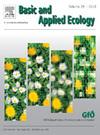矮灌木可通过调节小气候减轻气候变化对蜘蛛的负面影响
IF 3.5
2区 环境科学与生态学
Q2 ECOLOGY
引用次数: 0
摘要
气候变化对全世界节肢动物的生物多样性产生了负面影响。缓解由此造成的节肢动物减少是一项巨大挑战。开阔地区的矮灌木可以通过减少到达地面的太阳辐射和减弱土壤表面附近的空气流通来缓冲微气候的极端影响。森林草原是森林和草原的混合体,覆盖了欧亚大陆的广大地区。这种异质性生态系统为我们提供了研究干旱草原上小型栖息地特征(即矮小灌木)的影响以及比较迷迭香叶柳(Salix rosmarinifolia)灌木与森林斑块内部、开阔草原及其边缘动物群的机会。我们假设矮灌木小生境的小气候比开阔草地湿润凉爽,蜘蛛群落组成也与其他森林草原小生境不同。我们用数据记录仪记录了小气候参数,用 TDR 测量了土壤湿度,并用坑式陷阱收集了地栖蜘蛛。我们发现森林的土壤湿度(6.26 ± 1.21%,平均值 ± 95% 置信区间)和空气湿度(80.19 ± 3.19%)最高,草原最低(分别为 4.36 ± 0.65%;66.59 ± 2.53%)。最温暖的小生境是草原(23.23 ± 0.51°C),而最凉爽的小生境是森林(18.92 ± 0.41°C)。与周围的半荒漠草原相比,矮灌木丛的独特小气候更凉爽(21.46 ± 0.41°C)、更湿润(5.43 ± 0.53%)。此外,我们还发现森林、边缘地带、草地和矮灌木微生境中的蜘蛛群落组成和性状状态组成各不相同。森林(9.90 ± 0.95)和边缘(11.44 ± 1.27)的物种丰富度高于草原(7.08 ± 4.27)和矮灌木(5.09 ± 1.33)。与矮灌木微生境相比,我们在边缘地带采集到的蜘蛛体型更大。矮灌木的小气候和蜘蛛群落组成与草地不同。森林草原地区的气候变化被认为是由变暖和干燥共同驱动的。据预测,未来几十年干旱的频率和严重程度都将增加。木本植被,甚至是矮灌木,会产生热量和湿度异质性,这可能有助于节肢动物通过行为体温调节来缓冲宏观气候变暖。因此,它们在草原上的存在有利于保护专门的草原节肢动物。本文章由计算机程序翻译,如有差异,请以英文原文为准。
Dwarf shrubs may mitigate the negative effects of climate change on spiders by moderating microclimate
Climate change negatively affects arthropod biodiversity worldwide. Mitigating the resulting arthropod decline is a great challenge. Dwarf shrubs in open areas might buffer microclimatic extremities by reducing the solar radiation reaching the ground and weakening air circulation near the soil surface. Forest steppes are mosaics of forests and grasslands covering a vast area in Eurasia. This heterogeneous ecosystem offers the opportunity to study the effect of small habitat features, i.e. dwarf shrubs, in dry grasslands and compare the fauna of rosemary-leaved willow (Salix rosmarinifolia) shrubs with forest patch interiors, open grasslands and their edges. We hypothesized that the dwarf shrub microhabitat has a wetter and cooler microclimate than open grassland and a different spider community composition than other forest-steppe microhabitats. We recorded microclimatic parameters with data loggers, measured soil moisture with TDR and collected ground-dwelling spiders with pitfall traps. We detected the highest soil moisture (6.26 ± 1.21%, mean ± 95% confidence interval) and air humidity (80.19 ± 3.19%) in forests and the lowest in grasslands (4.36 ± 0.65%; 66.59 ± 2.53%, respectively). The warmest microhabitats were grasslands (23.23 ± 0.51°C), whereas the coolest microhabitats were forests (18.92 ± 0.41°C). The distinct microclimate of dwarf shrubs was cooler (21.46 ± 0.41°C) and moister (5.43 ± 0.53%) than the surrounding semi-desert like grassland. Furthermore, we found a different spider community composition and trait state composition of spiders in forests, edges, grasslands and dwarf shrub microhabitats. Forests (9.90 ± 0.95) and edges (11.44 ± 1.27) hosted a higher species richness than grasslands (7.08 ± 4.27) and dwarf shrubs (5.09 ± 1.33). We collected larger spiders on the edges than in dwarf shrub microhabitats. The dwarf shrubs hosted a different microclimate and spider community composition from the grassland. Climate change in the forest-steppe region is assumed to be driven by a combination of warming and drying. In the coming decades, drought frequency and severity are predicted to increase. Woody vegetation, even dwarf shrubs, creates a thermal and moisture heterogeneity that might aid arthropods in buffering macroclimatic warming through behavioural thermoregulation. Therefore, their presence on grasslands can benefit the conservation of specialised grassland arthropods.
求助全文
通过发布文献求助,成功后即可免费获取论文全文。
去求助
来源期刊

Basic and Applied Ecology
环境科学-生态学
CiteScore
6.90
自引率
5.30%
发文量
103
审稿时长
10.6 weeks
期刊介绍:
Basic and Applied Ecology provides a forum in which significant advances and ideas can be rapidly communicated to a wide audience. Basic and Applied Ecology publishes original contributions, perspectives and reviews from all areas of basic and applied ecology. Ecologists from all countries are invited to publish ecological research of international interest in its pages. There is no bias with regard to taxon or geographical area.
 求助内容:
求助内容: 应助结果提醒方式:
应助结果提醒方式:


